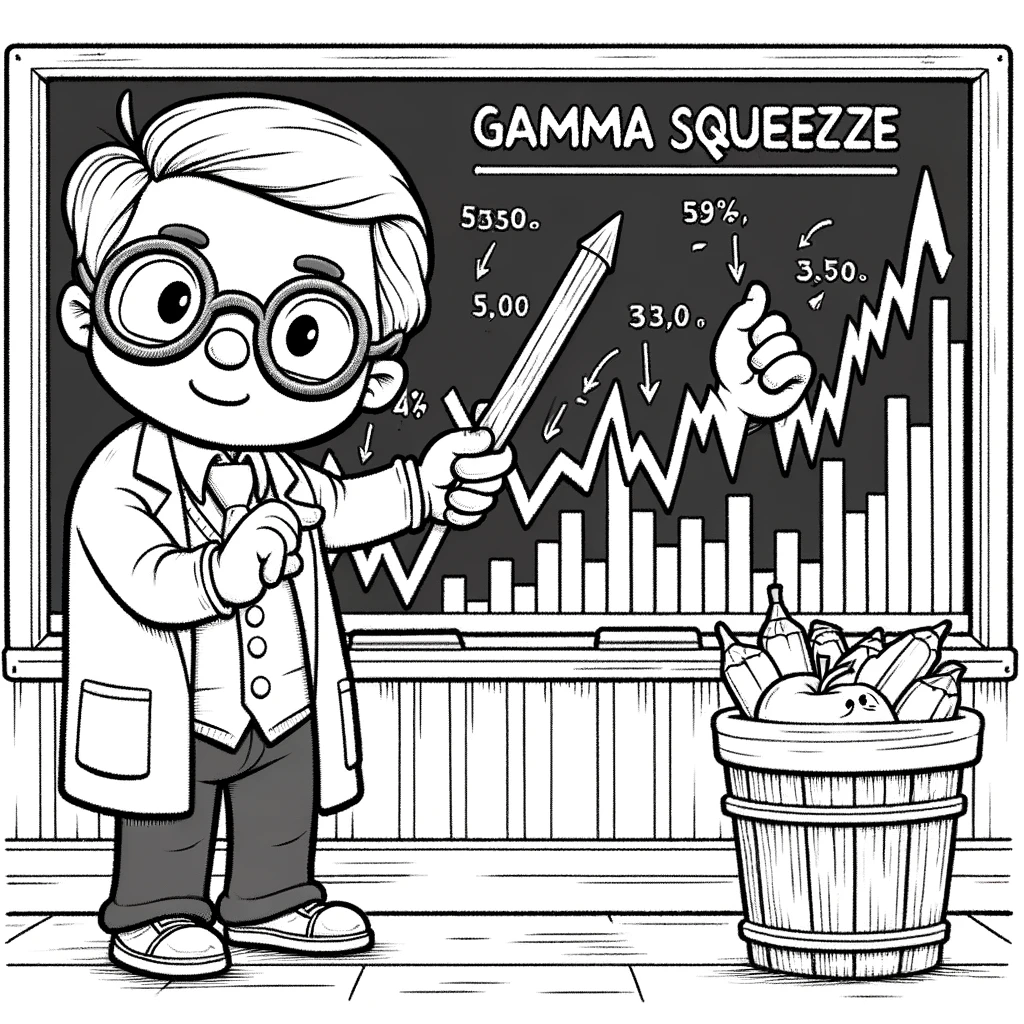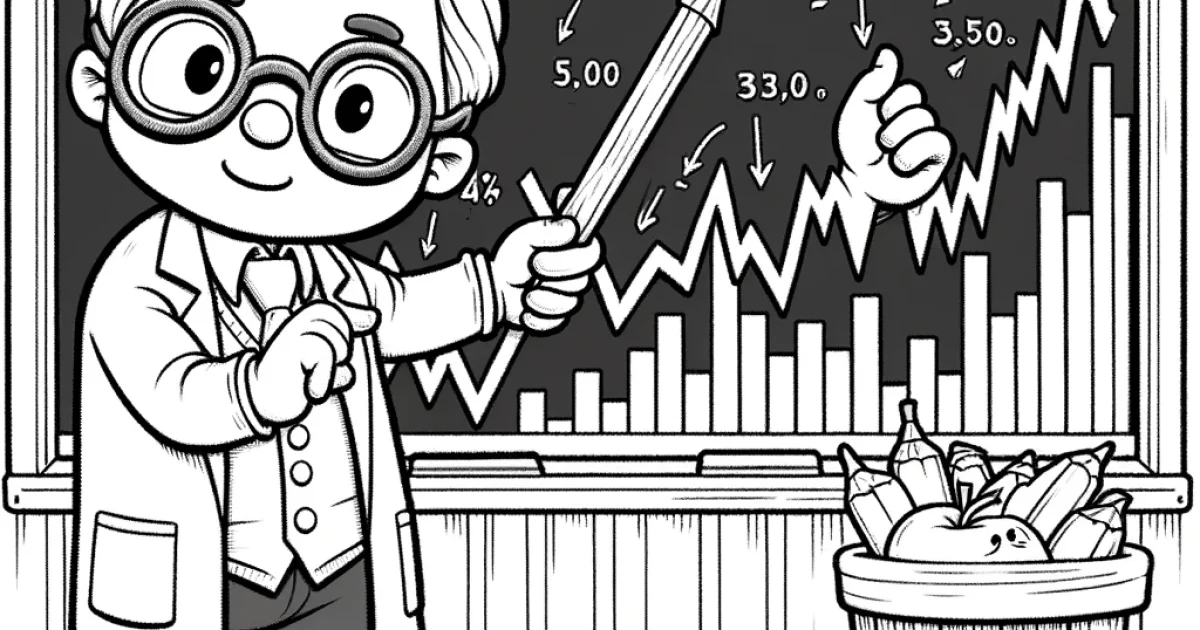In the dynamic world of stock trading, the term “gamma squeeze” is something you may have come across when the investment gurus are talking about crazy stock market swings. At its core, a gamma squeeze is a complex phenomenon that occurs when an increase in the price of a stock leads to “required buying activity” in that stock which further drives its price up…

This event is closely tied to options trading and the intricate interplay of “The Greeks,” which are key metrics used to assess and manage the risks of an option position.
The affects of a gamma squeeze are a bit like a whirlwind that can sweep up stock prices and create a buzz in the market. Imagine you’re watching a balloon inflate super fast—that’s kind of what happens to a stock’s price during a gamma squeeze. Just like the balloon that will eventually fall back to earth after being pulled up by the whirlwind, so too do the stock prices that got pulled up by the gamma squeeze; they typically fall back down too…
This guide is here to help you understand what a gamma squeeze is, how it affects the stock market, and why it’s something to keep an eye on, even if you’re not a finance whiz.
Basics of Options Trading
What Are Options?
Options are like special tickets in the stock market. They let you buy or sell a stock at a certain price before a specific date. There are two types: call options (for buying) and put options (for selling).
Why People Use Options…
People use options to bet on whether a stock’s price will go up or down. It’s a way to potentially make money without actually owning the stock. Some people also use options to protect their investments, like an insurance policy for their stocks.
Understanding “The Greeks” in Options Trading
Delta: The Change Tracker
Delta is a way to measure how much the value of an option might change when the stock’s price changes. If the delta is 0.5, it means the option’s value could go up by 50 cents for every $1 increase in the stock’s price.
Gamma: The Speedometer
Gamma tells us how quickly the delta can change. If gamma is high, it means the delta (and therefore the option’s value) can change rapidly with even small moves in the stock’s price.
What is a Gamma Squeeze?
The Players: Investors and Market Makers
In a gamma squeeze, two main groups are involved: investors who buy and sell stocks and options, and market makers who create options and help keep the market running smoothly.
The Squeeze Begins
A gamma squeeze is like a snowball rolling down a hill, growing bigger and faster as it goes. It all starts when a bunch of investors buy call options on a stock, hoping the price will shoot up. These call options are like bets that the stock’s price will rise above a certain level by a certain date.
Now, enter the market makers. These are the folks who create the contract between buyers and sellers, filling the orders. They’re a bit like bookies in a betting game, trying to balance their books so they don’t lose money. When lots of call options are being bought, there might not be as many other investors selling them.
This is where the market maker steps in. They sell the option contract and assume the risk. Since they don’t want to make money on the stock market movement, they have to have a strategy to protect themselves. They do this by buying the actual stock that the options are for. This is called “delta hedging.” This way, as the stock price increases and they lose money on the options they sell, they are offsetting that loss with the stock position they bought to “hedge” themselves. This way, they can fill any an all orders for options the market demands and not have to worry about losing money.
From an investors standpoint though, here’s the twist: when market makers buy more and more stock to hedge the options they have sold, it pushes the price of the stock up. This makes the call options more valuable, there delta increases and the market makers have to buy even more stock to stay balanced. It’s a cycle that can make the stock price zoom up like a rocket.
Again, why do market makers buy the stock in the first place? They do it to offset the risk of the options they created and sold. If the stock price goes up, the call options will be worth more, and the market makers will lose money on that position. But when they hedge themselves and own the stock, they offset those losses because the stock they own will be worth more as its price goes up.
I want to make a big point here – During a Gamma Squeeze, it isn’t investors buying the stock causing it to skyrocket – it is the market makers buying the stock. There are consequences to this…
The End of the Squeeze
So, what happens when the music stops, and the gamma squeeze comes to an end? It’s a bit like the end of a party when everyone starts heading home. The squeeze slows down or stops when investors stop buying call options. Some option buyers “cash in” and sell back their options to the market makers for a profit. When that happens, the market makers sell the stock they had bought to hedge with using the profit to pay the loss they had with the option. When that happens, the price may fall…
When the option contract finally expires, the market makers no longer have the liability of the options they sold. They sell the stock they own to the option holder who takes delivery if the “strike price” is lower than the stock price. If the stock price is lower than the option price, they just “dump” the stock back on the open market.
Market makers have a primary objective to make money by filling orders and selling options, not by betting on stock price movements. They’re like car dealers who want to make money by selling cars, not by speculating on car prices or casino bookies. Maybe this is why so many people believe the stock market is like a casino…
When the gamma squeeze ends, the excitement fades and investors might also start selling their stocks too. It’s like when a balloon deflates after being stretched too big. The stock price might return to a more normal level, based on the company’s actual value and performance.
The end of a gamma squeeze is a crucial moment. It’s when market makers unwind their positions, and the stock price finds its new equilibrium. Understanding this process is key to grasping the dynamics of a gamma squeeze and its impact on the stock market.
Identifying and Trading a Gamma Squeeze
Spotting a Gamma Squeeze
To identify a gamma squeeze, look for a sudden increase in a stock’s price along with a high volume of call options being bought. Financial news and stock market forums can also give clues about potential gamma squeezes.
Trading Strategies during a Gamma Squeeze
If you’re caught in a gamma squeeze, it’s important to have a plan and not get caught up in an emotional whirlwind yourself. Some successful traders might ride the wave and sell at a profit (remember “Pigs get fat; Hogs get slaughtered”), while others might stay cautious and avoid getting involved. Many novice investors buy at the peak of a gamma squeeze not having any idea what is going on and end up losing money…
Always consider the risks and have a strategy that fits your investment goals. I will explain this idea a little more…
The Impact of Gamma Squeezes on the Market
Short-Term Effects of Gamma Squeezes on The Stock Market
In the short term, a gamma squeeze can cause a lot of excitement and volatility in the stock market. It can lead to rapid price increases for the affected stock and sometimes even influence other stocks or the overall market.
Long-Term Effects of Gamma Squeezes on the Stock Market
The long-term effects of a gamma squeeze are less clear. While it can provide quick profits for some traders, it can also lead to losses, especially if the stock price falls sharply after the squeeze ends.
Role of Retail Investors during a gamma squeeze
In recent years, retail investors (ordinary people, not professional traders) have played a bigger role in gamma squeezes, thanks to social media and trading apps. They can band together to drive up a stock’s price, but they also face risks if the price suddenly drops.
In my COINS™ Strategy, when I see a gamma squeeze, I sell put options to earn money on their “decay” and wait until the squeeze reaches the top. At that time, I sell call options to the investors who are getting in late. Their options end up worth less than they paid – that money is my investors to keep…
Conclusion A gamma squeeze is a fascinating event in the stock market that can lead to dramatic changes in a stock’s price. By understanding how it works and its effects on the market, you can make more informed decisions about your investments and navigate the world of stock trading with confidence.



